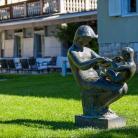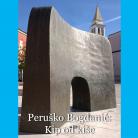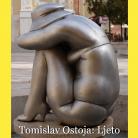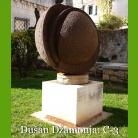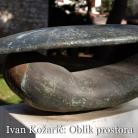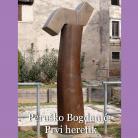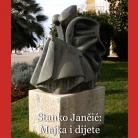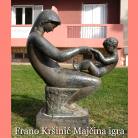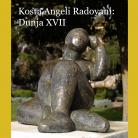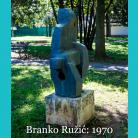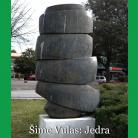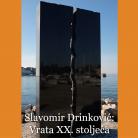Poreč Sculptures
SculpTours
The public collection of sculptures created by Croatia's greatest contemporary and modern sculptors boasts eleven pieces of art displayed in the very heart of Poreč. They were erected in the 1980s and 1990s, turning the town into an open-air gallery of modern sculpture. During the construction of tourism facilities in Poreč and its surroundings in early 1960s, a number of established Croatian painters and sculptors used to visit Poreč and Vrsar, and some were offered to create and exhibit their artwork there.
In 1983, the celebration of the Riviera hotel company's 30th anniversary featured the unveiling of the Mother's Play sculpture on the town’s coffeehouse terrace. The painters’ colony founded by Riviera back in those days remained active to date. The sculptures were very well received so other followed each year until the beginning of the Homeland War in 1991. Following a break, another two were put up, in 1995 and 1997, respectively.
(1)
Kip od kiše - The Rain Statue
Peruško Bogdanić (1949)
Failing to understand its significance and position in space, this sculpture was dubbed Štronco di bronco (translator’s note: offensive, literally Bronze Bastard) by the Poreč residents. The name became rooted in the oral tradition due to the humorous wordplay and the frequent use of it – the sculpture being one of the favourite meeting spots. This is a monumental, bronze cast stonemasonry work of art representing a fountain. It accentuates a clear concave tension, as if twisted by the northern wind, with the passage relieving the tension. It is reminiscent of a gate, and the shape of the passage is in harmony with the windows of adjacent buildings. The sculpture has a great auditive potential; it is an inexhaustive percussion instrument for the passers-by and a favourite playing spot for children.
(2)
Ljeto - Summer
Tomislav Ostoja (1931)
This sculpture was vandalised and thrown in the sea in 2006. It was thus completely destroyed; however, some remnants have nevertheless been preserved. This is perhaps the reason the citizens of Poreč refer to it as the Bather. In 2015, it was finally returned to its place after a long nine years. This work of art reminds the residents of Poreč of the beauty and the spirit of the summer days in this small tourist town. The author has created a series of sculptures titled Summer, with a humorous note contrasting the air of plainness in all of his works, arousing a feeling of uneasiness under the disguise of comfort. His almost faceless, voluminous characters are carefree, with their bodies juxtaposed in interrelated ways. The sculpture is highly suggestive, prompting the observers to ask themselves – is the woman sad, pensive, melancholic, tearful, sleepy or just lazily bathing in the sun?
(3)
C-3
Dušan Džamonja (1928 - 2009)
Džamonja experimented with his works using traditional materials in an innovative way. The technique of driving iron nails into a wooden core sculpture, only to be ultimately burnt and leaving a metal skeleton behind, brought new valuation of the interior space and light into Džamonja’s artwork. The C-3 sculpture boasts a leafed, spherical form of geometrical purity. Džamonja’s sculptures typically convey a symbolic, figurative meaning, and this one merely announces what can be seen at the Sculpture Park in Vrsar, opened for public in 1981.
(4)
Oblik prostora - The Shape of Space
Ivan Kožarić (1921)
This sculpture belongs to the author’s series of works dating back to the 1960s. Another one from the same series, only much bigger, stands in front of the Museum of Contemporary Art in Zagreb. These sculptures were made in the period of Kožarić’s creative work within the Gorgona art group. The sculpture plays with the possibility of representing both the interior and the exterior, both solids and voids. Its form is purified, abstract, symbolic and concise, with its expression deriving from the figurative forms aestheticized in a contemporary way.
(5)
Prvi heretik - The First Heretic
Peruško Bogdanić (1949)
In his quest for a primordial, mythical totem, the author reduces the form to basics and makes references to the pure late Modernist form with symbolic elements that he often draws from historical and mythological sources. Combining the constructivist approach with organic, suggestive forms, Bogdanić finds new ways of artistic expression through sculpture. He graduated from the Art Academy in 1976 without making a nude. At the time, this was unprecedented and almost 'heretical', and later proved to be a turning point in his career. The First Heretic is a totem attributed with many symbolic meanings, while its essential forms are contrasted and connected into dynamic structures. In 1996, Bogdanić became a mentor and in 2002 the art director of the Montraker International School of Sculpture in Vrsar.
(6)
Majka i dijete - Mother and Child
Stanko Jančić (1932 - 2018)
Jančić introduced trivial, everyday topics into Croatia's sculpture scene. He approached the image of a woman by criticizing the contemporary moment. Being interested in the relationship between volume and space and in particular the movement, he created a series of stylised small sculptures evoking the Futurist aesthetics. His analytical, metaphysical but also intimate approach greatly contributed to the theory of sculpture and earned him a prominent place in Croatian contemporary art. The aesthetics of small sculptures that he started rendering in 1975 in bronze, with the focus on space and movement, strongly evoked the Futurist dynamism, while the sculptures of women from the 1980s and the 1990s were created in a variety of forms. Mother and Child is a highly stylised, abstract sculpture, and this is especially accentuated in the shape of the heads. The focus is on the multi-layered, shattered surface, lending it a flowy and dynamic aspect clearly inspired by Futurism.
(7)
Majčina igra - Mother's Play
Frano Kršinić (1897 - 1982)
Mother's Play was created in 1942 and installed in Poreč in 1983 to mark the 10th anniversary of the Riviera hotel company. The sculpture resembles a cradle and is a vividly realistic representation of a mother and a child interpreted in a poetic manner. The body shapes are accentuated, cylindrical and conical, with a composition recalling a reversed pyramid. Its space is penetrated by an opening beneath the mother’s and child’s arms. Essential visual elements, soothing lines, balanced mass gradation and idealised, spiritual forms express the tenderness of motherhood, the beauty of youth and the female body erotic sensuality. Kršinić's works marked an end of the era of academic realism, Secessionist-style forms and national romanticism of the Medulić group in Croatia.
(8)
Dunja XVII
Kosta Angeli Radovani (1916 - 2002)
Some 20 female nudes, named Dunje (translator’s note: Dunja is a Croatian female name and a word used for quince) and characterised by voluptuous curves, occupy a special place in Radovani's oeuvre. As a fruit that needs time to ripen, quince (Dunja) personifies the female body – a primordial source of life and endurance. Two sculpting techniques, round volume and mass cutting, created a dynamic balance between the mass and the surface. Cubic forms prevail in his later works. The style of Dunja XVII is somewhere in-between Kršinić and Jančić. Its body belongs to the realm of sculpture, while its face, with barely accentuated volume, resembles a painting.
(9)
1970
Branko Ružić (1919 - 1997)
Inspired by indigenous influences from his native Slavonia (local tradition) and those collected while travelling in the 1950s (Lascaux, Stonehenge, Tarquinia), Ružić simultaneously created both archetypal and contemporary works. His original artistic expression was focused on essential organic forms infused with a striking internal dynamics and monumentality. 1970 is a sculpture representing a seated figure in a highly abstract form. It is lapidary and anthropomorphic, with accentuated personality. Typically for Ružić, the inner dynamics is prominent, and the figure is shaped as a suggestive anthropomorphic symbol bursting with vital force.
(10)
Jedra - Sails
Šime Vulas (1932 - 2018)
Vulas' sculptures are stripped off of superfluous elements and reduced to totems. Sails, candles, masts, towns, organs, gates and fortresses are some of the recurring themes in the author's oeuvre. In 1963 he created the first sculpture in the series titled Sails, a theme that marked his artistic expression. Regardless of its non-figurative nature, Vulas's work is strongly associated with his native Dalmatia and its tradition. He reinterpreted traditional themes reminiscent of his native land through contemporary methods and the use of traditional materials. Sails is a monumental sculpture with a dynamic bottom that creates rhythm and static imbalance.
(11)
Vrata XX. stoljeća - Door to the 20th Century
Slavomir Drinković (1951)
The eleventh sculpture, installed in 1997, is characterised by extremely simple forms, tense surfaces and relationships. It reminds the viewer of two magnets that simultaneously attract and repel one another. The Roman numerals X are inscribed on each of them, splitting the 20th century in two. Through the hole in-between the viewer can see the island of St. Nicholas (Sv. Nikola), the town's natural breakwater with a lighthouse, inhabited as early as prehistoric times. In recent years this uncultivated island has turned into an attractive tourist spot, so by peeking through the Door to the 20th century that at the same time enables and blocks the view, the viewer will experience what this century and the development of tourism brought to Poreč.












